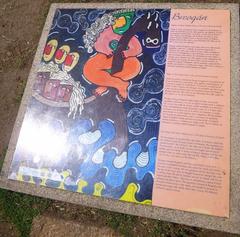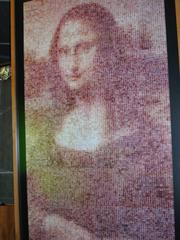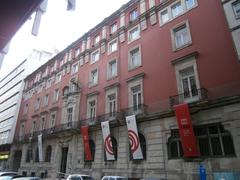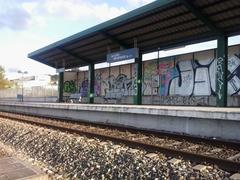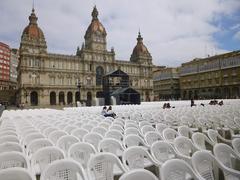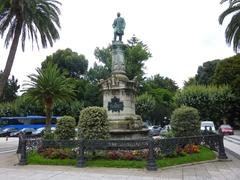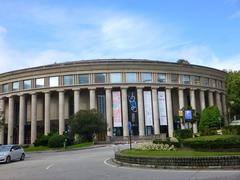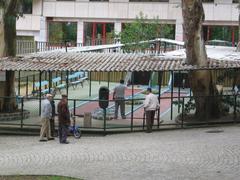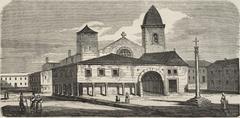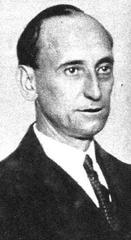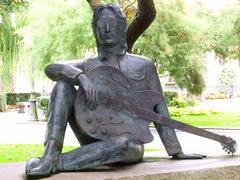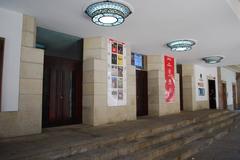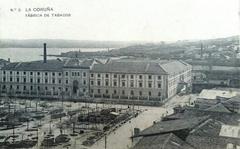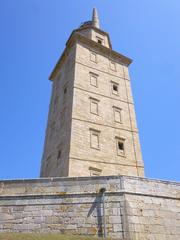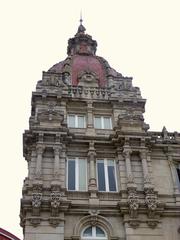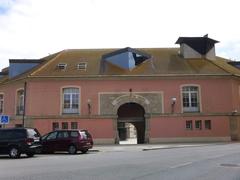Visiting Guide for Pazo De Mariñán in A Coruña, Spain
Publication Date: 16/08/2024
Welcome to Pazo De Mariñán
Pazo de Mariñán, an architectural gem nestled in Bergondo, A Coruña, Spain, offers a captivating journey through the rich tapestry of Galician history and culture. Initially constructed in the mid-15th century by Gómez Pérez das Mariñas as a defensive fortress, the site has undergone significant transformations, evolving into a grand baroque palace by the 18th century under the Counts of Andrade (turismo.dacoruna.gal). This historical marvel not only serves as a monument to Galicia’s noble past but also stands as a living museum of its cultural heritage. Visitors to Pazo de Mariñán can explore its meticulously preserved interiors, adorned with frescoes and antique furniture, and its expansive gardens, which are part of the European Route of Historic Gardens (viajargalicia.com). This guide aims to provide comprehensive information on the pazo’s historical significance, architectural highlights, practical visiting details, and more to help you plan an enriching visit.
Contents at a Glance
- Introduction
- Origins and Early History
- Transformation in the 18th Century
- 19th Century and Literary Influence
- 20th Century: From Private Ownership to Public Heritage
- Restoration and Modern Use
- Architectural Highlights
- Cultural and Historical Significance
- Visitor Information
- Practical Information for Visitors
- Frequently Asked Questions (FAQ)
- Conclusion
Discover the Historical Pazo De Mariñán: Visiting Hours, Tickets, and Cultural Significance
Introduction
Pazo de Mariñán stands as a testament to Galicia’s rich history and cultural heritage. This historical site in A Coruña offers visitors a unique glimpse into the past, with its origins dating back to the 15th century. In this article, you’ll learn about the fascinating history, architectural highlights, and practical visitor information, including visiting hours and ticket details, to help you plan your trip.
Origins and Early History
The origins of the Pazo de Mariñán date back to the mid-15th century. It was initially constructed as a defensive fortress by Gómez Pérez das Mariñas, a noble knight of the court of Juan II of Castile. Gómez Pérez das Mariñas played an active role in the Revoltas Irmandiñas, a series of popular uprisings against the feudal lords in Galicia. He self-styled himself as “Señor de las Mariñas, Mesía y Moscoso” (turismo.dacoruna.gal).
The initial construction was known as “Pazo de Bergondo,” not Mariñán. This fortress was part of a broader network of defensive structures built during a turbulent period in Galicia’s history (inspain.wiki).
Transformation in the 18th Century
In the 18th century, the Pazo de Mariñán underwent significant transformation under the ownership of the Counts of Andrade, one of the most powerful families in Galicia at the time. The fortress was converted into a palace, reflecting the wealth and influence of its owners. This period saw the introduction of Galician baroque architectural elements, including an elegant facade, ornate balconies, and wrought-iron gates (inspain.wiki).
The interior of the pazo was equally impressive, featuring a grand staircase, frescoed ceilings, and antique furniture. These changes marked the transition of the Pazo de Mariñán from a military stronghold to a symbol of nobility and cultural heritage (es.wikipedia.org).
19th Century and Literary Influence
The term “Pazo” generally designates large Galician houses in the countryside, often with heraldic aspects and sanctuaries. The consolidation of this term is attributed to writers such as the Countess Pardo Bazán, Valle-Inclán, and Otero Pedrayo. In the 19th century, the life and decadence of the pazos became a frequent motif in Galician literature (turismo.dacoruna.gal).
20th Century: From Private Ownership to Public Heritage
The last private owner of the Pazo de Mariñán was Don Gerardo Bermúdez de Castro, who frequented the aristocratic circles of Madrid. Known by his contemporaries as “Gerardo Láncara,” he was the reason the pazo was referred to as “Pazo de Láncara” for several years. Upon his death in 1936, unmarried and without children, he bequeathed the pazo to the Deputación de A Coruña for social purposes (turismo.dacoruna.gal).
Restoration and Modern Use
The Pazo de Mariñán and its gardens were declared a Historical-Artistic Site by Royal Decree on October 5, 1972. Between 1972 and 1975, the Deputación de A Coruña promoted extensive reconstruction and extension works, adding a new residential wing. Today, the pazo serves multiple purposes: it hosts institutional events, functions as a training center, and houses a museum that showcases a significant portion of the Deputación’s artistic collection (turismo.dacoruna.gal).
Architectural Highlights
The architecture of the Pazo de Mariñán is a testament to its historical evolution. The building has a U-shaped layout, a typical configuration for many Galician pazos. The main facade is dominated by an “imperial” staircase, flanked by stone sculptures of servants welcoming visitors. This grand entrance leads to a hall that serves as a reception area and distributor to other rooms (turismo.dacoruna.gal).
The rear facade features several fountains, Compostela-inspired vases, and exquisite granite balustrades reminiscent of the staircase at the Cathedral of Santiago in the Plaza del Obradoiro. The gardens, extending over 17 hectares, include a small vegetal labyrinth and the “Garden of the Word,” where illustrious visitors plant trees and leave messages (unmundoinfinito.com).
Cultural and Historical Significance
The Pazo de Mariñán is not just an architectural marvel but also a living example of Galician heritage. It has been carefully preserved to reflect the traditional Galician way of life. Visitors can experience this culture firsthand by exploring the pazo, dining in its restaurant, and attending cultural events and workshops (inspain.wiki).
The pazo is also part of the Ruta de la Camelia, an itinerary that highlights the gardens and pazos of Galicia where various camellia varieties bloom. This route attracts a growing number of visitors interested in botanical tourism, especially during the camellia flowering season (unmundoinfinito.com).
Visitor Information
Guided tours of the interior of the Pazo de Mariñán are available and recommended. These tours occur every 45 minutes from 11:00 to 14:00 and from 14:00 to 19:00 hours. Both the guided tours and the free exploration of the gardens are free of charge. There is also free parking available at the entrance (unmundoinfinito.com).
The gardens are open to the public from Monday to Sunday, from 9:00 to 21:00 hours from June 1 to September 15, and from 11:00 to 19:00 hours for the rest of the year. During the camellia flowering season, interior visits are limited to Fridays, Saturdays, and Sundays (unmundoinfinito.com).
Practical Information for Visitors
- Tickets: Entrance to the Pazo de Mariñán and its gardens is free of charge.
- Visiting Hours: The gardens are open from 9:00 to 21:00 hours from June 1 to September 15, and from 11:00 to 19:00 hours for the rest of the year.
- Guided Tours: Available every 45 minutes from 11:00 to 14:00 and from 14:00 to 19:00 hours.
- Parking: Free parking is available at the entrance.
- Accessibility: The pazo is accessible to visitors with limited mobility.
- Nearby Attractions: Explore other historical sites in A Coruña, such as the Tower of Hercules and the Casa de las Ciencias.
- Photography: Enjoy picturesque spots throughout the gardens and the architectural highlights of the pazo.
Frequently Asked Questions (FAQ)
Q: Is there an entrance fee to visit the Pazo de Mariñán? A: No, entrance to the Pazo de Mariñán and its gardens is free of charge.
Q: What are the visiting hours for the Pazo de Mariñán? A: The gardens are open from 9:00 to 21:00 hours from June 1 to September 15, and from 11:00 to 19:00 hours for the rest of the year.
Q: Are guided tours available? A: Yes, guided tours are available every 45 minutes from 11:00 to 14:00 and from 14:00 to 19:00 hours.
Q: Is the Pazo de Mariñán accessible to visitors with limited mobility? A: Yes, the pazo is accessible to visitors with limited mobility.
Conclusion
The Pazo de Mariñán stands as a monument to the rich history and cultural heritage of Galicia. From its origins as a 15th-century fortress to its transformation into an 18th-century baroque palace, and finally to its current role as a cultural and historical site, the pazo offers a unique glimpse into the past. Its well-preserved architecture, beautiful gardens, and cultural significance make it a must-visit destination for anyone interested in exploring the history and heritage of Galicia. Plan your visit today and immerse yourself in the enchanting world of the Pazo de Mariñán.
Sources and Further Readings
- Descubre el Pazo de Mariñán, (n.d.), Turismo de A Coruña source url
- Pazo de Mariñán, (n.d.), inspain.wiki source url
- Pazo de Mariñán, (n.d.), Wikipedia source url
- Pazo de Mariñán, (n.d.), unmundoinfinito.com source url
- Pazo de Mariñán, (n.d.), viajargalicia.com source url
- Pazo de Mariñán, (n.d.), Diputación de A Coruña source url


